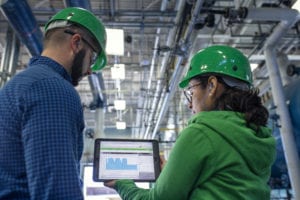While energy consumption regulations are increasingly being imposed worldwide, organizations continue to demonstrate that energy efficiency and the associated cost savings are beneficial for business. The International Standards Organization (ISO) has long recognized the need for improving energy efficiency in all types of commercial, institutional, and industrial facilities. To help drive this initiative, they developed the ISO 50001 standard for energy management systems, publishing the first edition in 2011.
As noted by the ISO, the goal of the ISO 50001 standard is to “enable organizations to establish the systems and processes necessary to continually improve energy performance, including energy efficiency, energy use and energy consumption. Successful implementation … supports a culture of energy performance improvement that depends upon commitment from all levels of the organization, especially top management.” The guidance the standard provides can help turn energy efficiency novices into top energy performers. It’s user-friendly toolset helps organizations identify, track, report, and act on all energy improvement initiatives.
New edition, new guidance
The ISO recently published a new edition of the standard, the first major revision since its first release. The updates in the ISO 50001: 2018, Edition 2 focus mainly on making sure high-level leadership is engaged, risks are identified up front, the right data is collected, all factors are taken into account, and terminology is clearly understood. Let’s have a closer look at some of these changes. Relevant sections of the standard are noted.
- To better understand the context of the organization– The new edition requires a global analysis of the organization, to ensure that it considers all of the internal and external stakeholders that may affect the outcome of energy management initiatives. (Section 4)
- To reinforce leadership and commitment of top management – Previously, a single management representative was designated. Now, top management must “demonstrate leadership and commitment”, and assign responsibility and authority to an “energy management team”. (Section 5.1 and 5.3)
- Analyze risks and opportunities before planning – Whereas it was acceptable before to take preventative measures on anything that might impact energy performance, the new edition requires an earlier, deeper analysis of all risks that might affect performance, as well as opportunities to prevent or reduce undesired effects. (Section 6.1
- Normalize to improve the capability of comparison – When setting an energy performance baseline to compare progress against, it’s now requested to take into account:
-
- a. Relevant variables such as weather (temperature), operating conditions, working hours, and production output.
-
- b. Static factors such as facility size and number of weekly shifts should also be considered.
This process of ‘normalization’ enables the energy performance of different facilities or processes to be compared under equivalent conditions for greater accuracy. (Sections 6.3, 6.4, 6.5)
-
- Plan earlier for data collection – The new edition requires a data collection plan to be specified earlier, right from the Planning stage. It should define exactly what kinds of data will be collected, how frequently, and why it is needed to support energy performance improvements. (Section 6.6) Further useful information about measurement plans will be found in the EN 17267 standard, which is expected to be published sometime in 2019.
- Communicating externally – Previously, the ISO 50001 standard required only internal communication. The new edition wants any requirement for external communication to be defined, including what information will be shared. (Section 7.4)
- Continuously improve – The new edition clarifies what is meant by energy performance improvement, specifically “improvement in measurable results of energy efficiency (3.5.3), or energy consumption (3.5.2) related to energy use (3.5.4), compared to the energy baseline (3.4.7)”. (Section 10.2)
Below is a summary of the main standards applicable in the field of energy efficiency:
Main standards or rules (applicable to a plant, commercial building, etc.) |
Complementary standards (applicable to a plant, commercial building, etc.) | Usual product Standards
(power meters and data gateways) |
| ISO 50001
Energy Management Systems – Requirements with guidance for use Green labels for buildings (LEED, BREEAM, HQE, E+C-, DGNB, Passivhaus, Title24, Minergie, , etc.) |
ISO 50006
Energy Baseline (EnBs) & Energy Performance Indicators (EnPIs) IEC 60364-8-1 Low voltage installations – Part 8-1: Energy Efficiency pr EN 17267 Energy measurement and monitoring plan for an organization — Design and implementation. Principles for energy data collection |
IEC 61557-12
Power Metering and Monitoring devices (PMD)
IEC 62974-1 Monitoring and measuring systems used for data collection, gathering and analysis – Part 1: Device requirements |
Best practices need the best tools
Of course, executing a comprehensive energy management plan is a lot easier when your team has the right tools in place. The next-generation EcoStruxure™ Power platform from Schneider Electric has obtained ISO 50001, ISO 50002 and ISO 50006 certification. It’s the first comprehensive digitally-connected power management system to receive this internationally-recognized endorsement. With ISO-compliant energy data management, EcoStruxure Power simplifies the steps for organizations to reach their energy and sustainability goals. For information on other standards, as well as access to additional resources, training and product information, consider registering for our dedicated Consulting Engineer portal.

